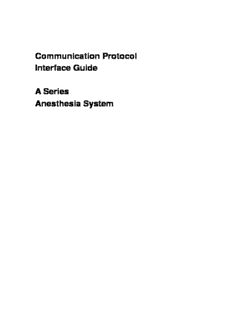Table Of ContentCommunication Protocol
Interface Guide
A Series
Anesthesia System
Table of Contents
1 Overview .............................................................................................................. 1-1
1.1 Introduction ................................................................................................. 1-1
1.2 References .................................................................................................. 1-2
1.3 Physical Connections .................................................................................. 1-3
1.3.1 Network Port...................................................................................... 1-3
1.3.2 Serial Port.......................................................................................... 1-4
1.4 Interface Protocols ...................................................................................... 1-5
1.4.1 DEC Profile: Unsolicited Results .................................................... 1-5
1.4.2 CT Profile: Time Synchronization ................................................... 1-5
1.5 Use Cases ................................................................................................... 1-6
1.6 Applicable Scope ......................................................................................... 1-7
2 Communication Protocol Layers ....................................................................... 2-1
2.1 Introduction to the A Series Export Protocol ................................................ 2-1
2.1.1 Physical Layers ................................................................................. 2-1
2.1.2 TCP Layer ......................................................................................... 2-3
3 System Setup ...................................................................................................... 3-1
3.1 Anesthesia System Setup ........................................................................... 3-1
3.1.1 Network Port Setup ........................................................................... 3-2
3.1.2 Serial Protocol Setup......................................................................... 3-3
3.1.3 Demographics Setup ......................................................................... 3-4
3.2 Time Synchronization Setup........................................................................ 3-5
4 A Series Export Protocol .................................................................................... 4-1
4.1 DEC Profile: Unsolicited Results .............................................................. 4-1
4.1.1 Supported Transmission Data ........................................................... 4-2
4.1.2 Message Details: PCD-01 ................................................................. 4-3
4.1.3 DEC Message Example ...................................................................4-11
4.1.4 Networking ...................................................................................... 4-15
5 Time Synchronization ......................................................................................... 5-1
5.1 CT (Consistent Time) Profile: ...................................................................... 5-1
5.2 Introduction to the SNTP Protocol ............................................................... 5-2
5.2.1 UDP Layer ......................................................................................... 5-2
5.2.2 Packet Assembly ............................................................................... 5-3
5.2.3 SNTP C/S Illustration ........................................................................ 5-4
A CRC Calculation.................................................................................................. A-1
i
A.1 Overview ..................................................................................................... A-1
A.2 CRC Calculation Guidance ......................................................................... A-1
B A Series HL7 Export Nomenclature .................................................................. B-1
B.1 General ID Allocation Scheme for “99MNDRY” Terms ................................ B-1
B.2 A Series - Anesthesia Machine Containment Tree ...................................... B-2
B.3 Units of Measure ......................................................................................... B-3
B.4 Ventilator / Anesthesia Machine Settings IDs ............................................. B-4
B.5 Ventilation Modes........................................................................................ B-5
B.5.1 Ventilation Mode Enumeration .......................................................... B-6
B.6 System Status ............................................................................................. B-7
B.6.1 Device Status Enumeration ............................................................... B-8
B.6.2 Device Mode Enumeration ................................................................ B-8
B.6.3 Patient Type Enumeration ................................................................. B-9
B.6.4 Warmer On Enumeration .................................................................. B-9
B.7 Patient Measurements .............................................................................. B-10
B.8 Ventilator / Anesthesia Machine Measurement IDs .................................. B-11
B.9 Airway Gas Analyzer Measurement IDs .................................................... B-12
C A Series HL7 Simulator Instructions................................................................. C-1
C.1 Overview ..................................................................................................... C-1
C.2 Simulator Setup .......................................................................................... C-1
C.3 Keyboard Shortcuts .................................................................................... C-3
ii
1
Overview
1.1 Introduction
This guide is intended to be used by software developers and/or systems integrators
that wish to communicate with Mindray A Series anesthesia systems that have
software bundle version 02.02.00 through 02.10.00. Future versions of firmware may
support additional measurements, settings and/or modes.
The A Series Anesthesia Systems can communicate measurements and settings to
other systems such as clinical IT systems. This is done using an HL7 based protocol
based on the Integrating the Healthcare Enterprise (IHE) Patient Care Devices (PCD)
Device to Enterprise Communication (DEC) profile. This document provides specifics
on how the A Series Anesthesia Systems implement this profile.
1-1
1.2 References
(cid:131) HL7 V2.6
(cid:131) IHE PCD Technical Framework Volume 1
(cid:131) IHE PCD Technical Framework Volume 2
(cid:131) IHE ITI Technical Framework Volume 1
(cid:131) IHE ITI Technical Framework Volume 2
(cid:131) IHE PCD Rosetta Terminology Profile
(cid:131) ISO/IEEE 11073-10101 Nomenclature
(cid:131) IETF RFC 2030 SNTP
1-2
1.3 Physical Connections
The A Series anesthesia system can communicate via the Network Port and the
Serial Port. Both ports can be used simultaneously.
1.3.1 Network Port
The A Series anesthesia system can communicate using Ethernet. A standard
10/100 Base-T connector is located at the back of the machine for this purpose.
Refer to the illustration below:
1-3
1.3.2 Serial Port
The A Series anesthesia system can communicate using a Serial Port. A RS-232
asynchronous serial interface is located at the back of the machine for this purpose.
Refer to the illustration below:
1-4
1.4 Interface Protocols
The messaging protocols used by the A Series anesthesia systems are based on
profiles established by the Integrating the Healthcare Enterprise (IHE) organization
Patient Care Devices (PCD) domain. Two different profiles are supported.
1.4.1 DEC Profile: Unsolicited Results
The A Series supports sending unsolicited results at a 10 second interval. Shorter or
longer intervals are allowed by configuration.
1.4.2 CT Profile: Time Synchronization
The A Series device supports the IHE Consistent Time (CT) Profile (ITI-01) only on
the Ethernet port.
This profile supports the synchronization of time between a Time Server and a Time
Client and is based on the IETF standard SNTP protocol. The Time Client periodically
transmits synchronization request (using UDP) to the Time Server. The request
interval as well as IP Address of the Time Server is configured on the Anesthesia
System.
1-5
1.5 Use Cases
There are two general Use Cases that have been considered in development of the A
Series Interface Protocol:
1. Point-to-Point:
Interface of an A Series Anesthesia System (DOR) directly to a local data consumer
(DOC) such as a patient monitoring system or clinical information system. This
scenario can be an implemented via either the Serial Port (RS232) connection or the
Network Port (Ethernet) using a point-to-point topology.
It is unlikely that the DOC will also support the Time Server functionality, so that any
data collected by the DOC should be time-stamped by the DOC as of the time of
receipt. In a point-to-point scenario, the DOC is also responsible for associating the
data with the appropriate patient.
2. Networked:
Interface of an A Series Anesthesia System over a network using the Network Port to
a DOC which is typically a clinical IT system. In this case the network probably also
has a network Time Server which the Anesthesia System can use to synchronize its
clock.
In this situation it is also very important that the system end-user associate the device
with the proper patient either through location or through entry of key patient
demographics into the A Series anesthesia system.
1-6
Description:2 Communication Protocol Layers . Interface of an A Series Anesthesia System over a network using the Network Port to a DOC which is .. Set ID OBR. R. Incremented value. R Incremented value. OBR-2. Placer Order. Number. R. X EMPTY. OBR-2.1. Entity identifier. R. Same as MSH-10. OBR-2.2.

